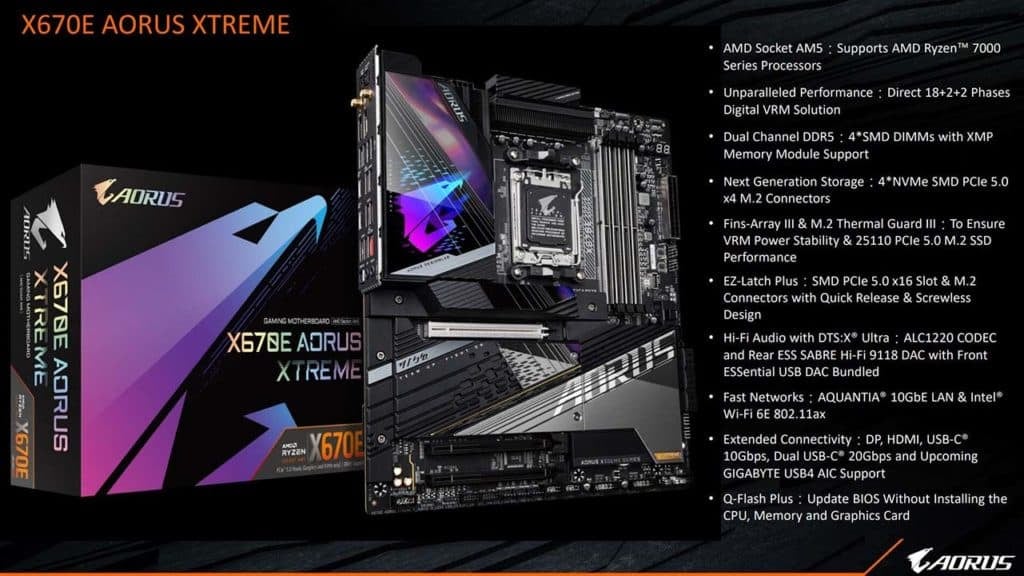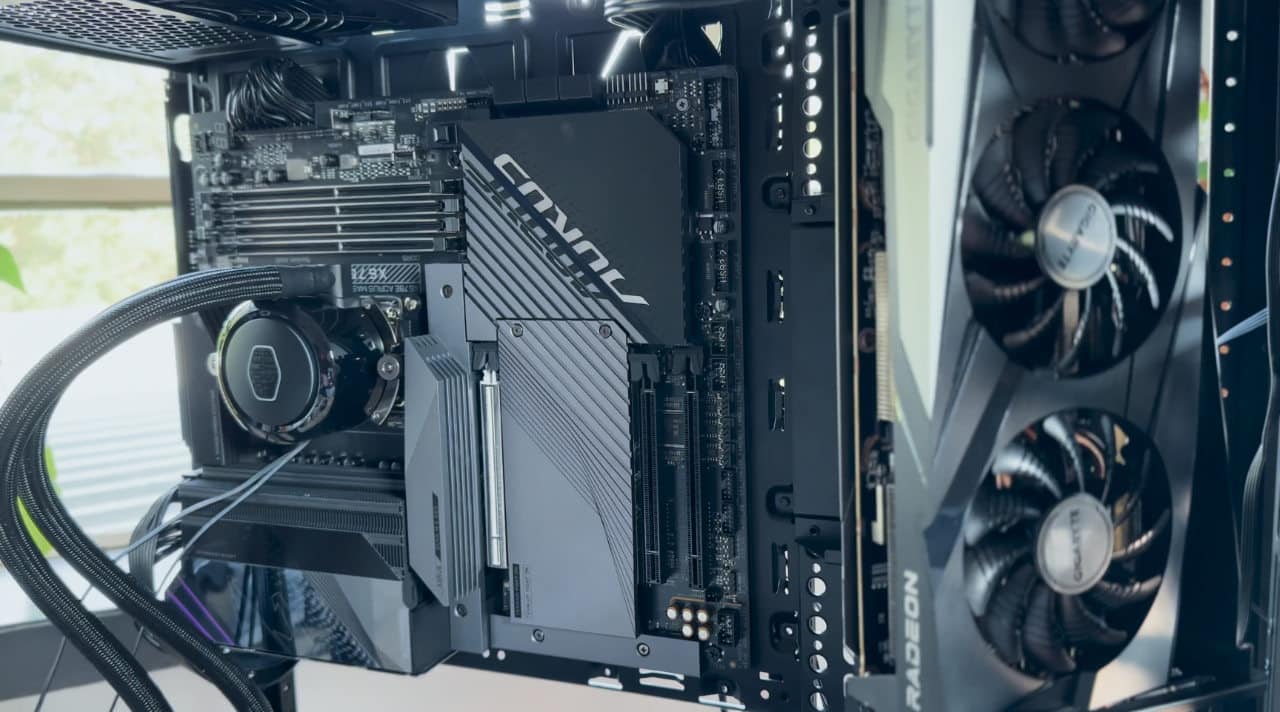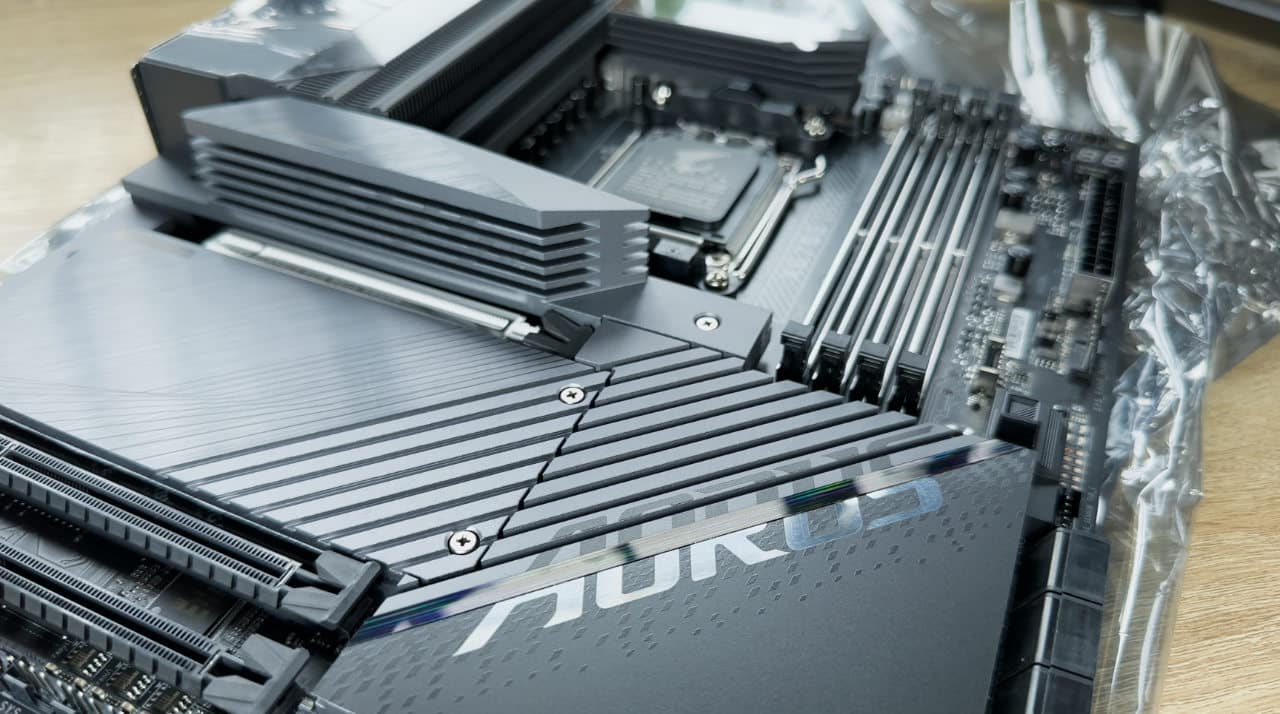As tech moves forward each year PC hardware need to be ready to adopt new CPUs and other components. The Gigabyte Aorus X670E Master motherboard is one of the latest pieces of tech to come out of the company and it marks a ridiculous price point for those looking to adopt a new AMD Ryzen 7000 CPU. The board is pretty much future-proof at this stage thanks to its implementation of PCI-E 5, Gen 5 SSD support and even advanced power adoption. So those looking to invest in something that you can simply expand upon in the months ahead, this board is definitely for you.
Watch this full review below
For me, the Gigabyte Aorus X670E Master marked an exciting time for PC equipment because I was on the journey to build a whole new PC build around this motherboard. Alongside another Gigabyte GPU, which I had in my cupboard for a few months now, I decided to build this new PC from the ground up and it was exciting to use the latest hardware and this beastly AMD Ryen 7700X. So this review will tackle the Gigabyte Aorus X670E Master, the Ryzen 7700X CPU and Gigabyte AMD Radeon RX 6750 XT GAMING OC 12GB GPU.
I will also be covering the Cooler Master Cosmos C700M case and Masterliquid 360R in a later video/post where I will go through the challenges and lessons I learnt using one of the most advanced gaming cases you can buy on the market. But for now, let’s tackle this motherboard.
The Gigabyte Aorus X670E Master might have a price tag above R10k but it doesn’t really look and feel that expensive. In fact, in comparison to other motherboards on the market, it is quite subtle and if anything, simple. However, that doesn’t mean this X670E isn’t a powerhouse because it really packs some great features. Features many of you will probably not use for a while. The X670E features PCI-E 5.0 for SSDs and GPUs as well as more stability and power phases for those who enjoy overclocking their CPU and RAM. It also goes without saying that the motherboard supports the latest DDR5 RAM.
I won’t go into full detail on each of the specs on this X670E motherboard. Instead, you can see them in front of you now:
3 x4 PCI-E 5.0 Slots 1 x4 PCI-E 4.0 Slot 2x USB 3.2 Gen2
4x USB 3.2 Gen1
1x USB 3.2 Gen2x2 Type-C 4x USB 3.2 Gen1 You can see from the specs that the X670E comes equipped with everything you can expect from a modern-day board in 2022. It doesn’t have USB4 but there’s really nothing more you can ask for here and the inclusion of all these ports, alongside the great internal IO makes this board as feature-packed as possible. I have to acknowledge how great it was to have the best performance available for every task I had to get done. I wanted to connect my Xbox Wireless Controller to the PC, it had Bluetooth. The same can be said for the Wi-Fi 6E support. These little things made quite a big difference in how I approached using my new PC.
The X670E doesn’t change the game when it comes to the design. I have used some rather extravagant motherboards in the past few months and this one is a lot calmer than any of them in the past. The only real RGB you’ll find here is on the Aorus logo outside the IO port housing. See what I meant about “subtle”? This doubles up as a heatsink. Gigabyte really went hard with the heatsinks on this motherboard and you can see how the various pieces have been carefully slotted together to dissipate heat.
The board packs some useful extended heatsinks across the top to help keep the SSD enclosures cool. These enclosures are packed neatly under a screw-top surface that has to be removed in order to install the storage device. Here, you’ll find the Gen 5 and Gen 4 SSD ports. I don’t have a Gen5 SSD to use yet but it is nice to know that this board is ready for whenever this does happen. The board also includes PCI Express 5 for the newest GPUs. I don’t have one of those yet either but again, nice to have these ports ready.
There’s also a quick-release latch on the PCI-E slot to quickly release your GPU. However, I used a riser card to build this PC because I wanted to use the verticle GPU mount and I didn’t have a card that required PCI-E 4 or PCI-E 5
In terms of thermal housing, the X670E includes quite a number of heatsinks which aim to keep the motherboard cool during use. These heatsinks are also designed to help with the overclocking experience on the Ryzen 7000 CPUs. The motherboard’s 16+2+2 digital VRM design will help push the overclocking further and more naturally than on other boards.
The Q-Code indicator on the board also helps show you POST codes. If your PC isn’t booting up, you can see what code it is stuck on and try and figure out what the issue could be. You can also clear the CMSO using the button at the back of the IO or use Q-Flash to quickly install a new BIOS. I made use of these features quite a lot when I first installed the board because the BIOS had to be updated.
In the box, you’ll also get some extra wires and connectors. Everything in the box is mostly optional if you need to use them. The Q-Connector makes it easier to connect your power, LED and reset switch to the board, for example. There are also some extension cables in the box, some SATA cables, thermistor cables, velcro and the Wi-Fi dongle.
Installing the motherboard wasn’t difficult. The Cooler Master Cosmos C700M made this a breeze thanks to its external motherboard bracket. This meant I could install the board into the metal surface and then slot this into the PC. The CPU I received from Gigabyte is the Ryzen 7 7700X and that too was simple enough to install. This board comes with the latest AMD AM5 socket meaning previous Ryzen series CPUs are not compatible with the board. However, all previous coolers should work just fine thanks to the bracket design.
The board supports the latest DDR5-based DIMM RAM. With the latest BIOS update, you can get up to 5200MHz but by default, the board supports 4400 and 4800MHz. It can be maxed out at 128GB thanks to its four 32GB slots.
I combined this X670E Master with an AMD Ryzen 7700X CPU and benchmarked it for some performance stats. I ran PCMark 10, Performance Test, Cinebench and Geekbench 5. Here are the scores I got.
During all of these tests, I monitored the performance of the CPU. I also left the boost clocks at default to see what the raw performance would be for this CPU without the need to overclock and fiddle with settings. I then ran the tests again while trying to obtain AMD’s advertised 5.4GHz boost clock. After an hour of testing frequencies over 5GHz, the CPU maxed out at 95.4C I used the Cooler Master ML360 cooler attached to this CPU to run these tests. When doing single-core tests, I finally managed to see the 5.4GHz boost clock that comes enabled out-of-the-box. By default, a single-core thread hit 4954MHz.
I then tried to boost this even more. AMD says that even at 95C, its new AM5 chipsets aren’t technically running hot. These CPUs are designed to run at the highest clocks possible under 95C without damage. At its peak performance, the CPU was pulling 135W of power. This went to 139W on a multithreaded test. Temperatures remained under 97C and I managed to keep the boost clock at around 5.5GHz without any manual overclocking.
So let’s wrap this up. The Gigabyte Aorus X670E Master motherboard is made for the Ryzen 7 CPU and the combination of the two makes for a great performance experience. Of course, the cooler, case and GPU all contribute to this but I was impressed by the overall tests and stability of the motherboard and CPU.
The Ryzen 7700X provide some exceptional performance, especially for gaming. It overclocks to 5.4GHz and up without batting an eyelid and while the 95C temperature does get a bit concerning, AMD says it is normal so I say we just enjoy the ride. You’ll obviously be able to squeeze a lot more power out of this CPU the more you push it but for those who just want to slap it into their PC, you’ll be happy to know it performs quite well out-of-the-box.
The Gigabyte Aorus X670E Master motherboard is a costly piece of hardware and I would have loved to see a little bit more RGB on it at least. I know, I usually dislike more RGB but if I am spending R10,000 on a motherboard, it better light up my PC. In this case, it didn’t. Still, the motherboard is a sleek piece of hardware that looks great in the PC case. It is also ready for 40-series cards and Gen5 SSDs so I can’t wait to test all of that out too.
Features
Gigabyte X670E AORUS Master
CPU Overclocking Support
Yes
VRM Power Phases
16+2+2
PCI-E 5.0 Slots
1 x16 PCI-E 5.0 Slot
PCI-E 4.0 Slots
1 x16 PCI-E 4.0 Slot
USB Connections (Rear)
1x USB 3.2 Gen2 Type-C
USB Connections (Front)
1x USB 3.2 Gen2x2 Type-C
LAN Type
2.5 Gigabit LAN
WiFi Module
WiFi 6E
Gigabyte Aorus X670E Master Design
Gigabyte X670E AORUS Master Motherboard Review
-
Performance - 8.5/10
8.5/10
-
Design - 7.5/10
7.5/10
-
Value - 8/10
8/10
Summary
The Gigabyte X670E AORUS Master motherboard is a featured-packed if anything simple piece of tech made for the new AM5 AMD Ryzen 7000 CPUs and it performs well.
Overall
8/10Pros
Has everything you need
Future proof features
Generally great performance
Cons
Quite pricey
Could do with more RGB









